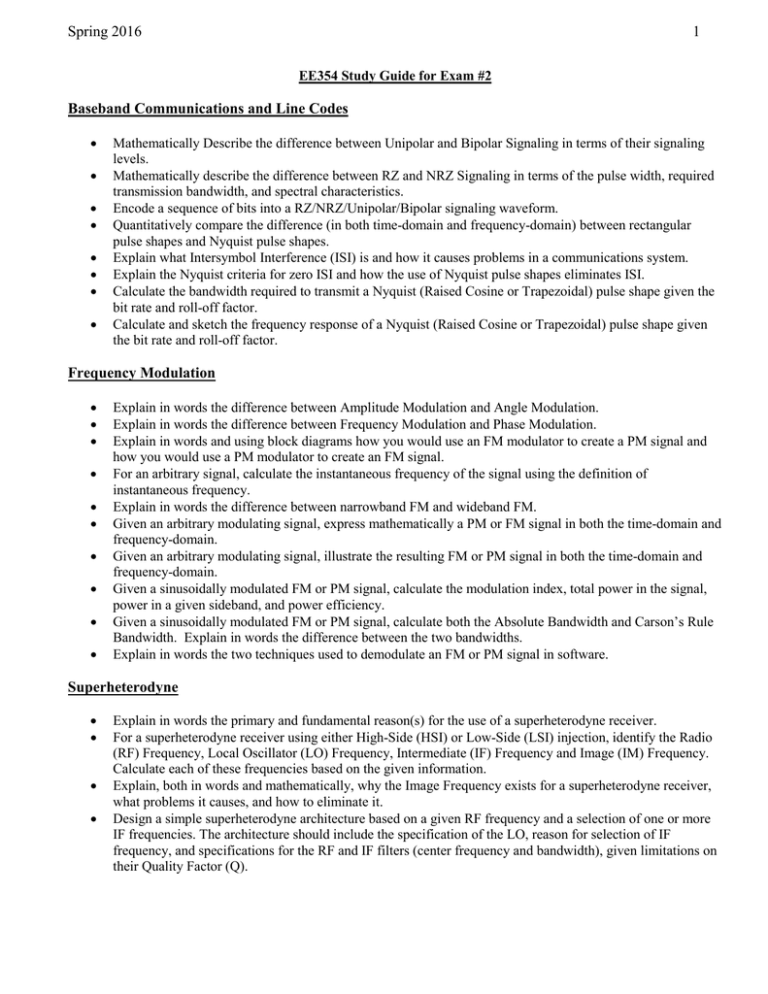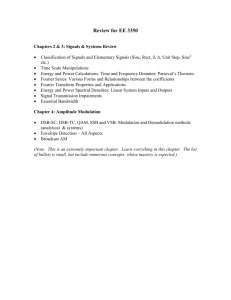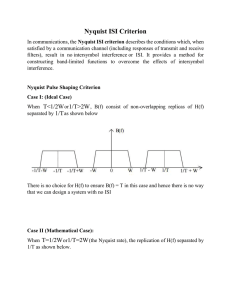Spring 2016 1 Baseband Communications and Line Codes
advertisement

Spring 2016 1 EE354 Study Guide for Exam #2 Baseband Communications and Line Codes • • • • • • • • Mathematically Describe the difference between Unipolar and Bipolar Signaling in terms of their signaling levels. Mathematically describe the difference between RZ and NRZ Signaling in terms of the pulse width, required transmission bandwidth, and spectral characteristics. Encode a sequence of bits into a RZ/NRZ/Unipolar/Bipolar signaling waveform. Quantitatively compare the difference (in both time-domain and frequency-domain) between rectangular pulse shapes and Nyquist pulse shapes. Explain what Intersymbol Interference (ISI) is and how it causes problems in a communications system. Explain the Nyquist criteria for zero ISI and how the use of Nyquist pulse shapes eliminates ISI. Calculate the bandwidth required to transmit a Nyquist (Raised Cosine or Trapezoidal) pulse shape given the bit rate and roll-off factor. Calculate and sketch the frequency response of a Nyquist (Raised Cosine or Trapezoidal) pulse shape given the bit rate and roll-off factor. Frequency Modulation • • • • • • • • • • Explain in words the difference between Amplitude Modulation and Angle Modulation. Explain in words the difference between Frequency Modulation and Phase Modulation. Explain in words and using block diagrams how you would use an FM modulator to create a PM signal and how you would use a PM modulator to create an FM signal. For an arbitrary signal, calculate the instantaneous frequency of the signal using the definition of instantaneous frequency. Explain in words the difference between narrowband FM and wideband FM. Given an arbitrary modulating signal, express mathematically a PM or FM signal in both the time-domain and frequency-domain. Given an arbitrary modulating signal, illustrate the resulting FM or PM signal in both the time-domain and frequency-domain. Given a sinusoidally modulated FM or PM signal, calculate the modulation index, total power in the signal, power in a given sideband, and power efficiency. Given a sinusoidally modulated FM or PM signal, calculate both the Absolute Bandwidth and Carson’s Rule Bandwidth. Explain in words the difference between the two bandwidths. Explain in words the two techniques used to demodulate an FM or PM signal in software. Superheterodyne • • • • Explain in words the primary and fundamental reason(s) for the use of a superheterodyne receiver. For a superheterodyne receiver using either High-Side (HSI) or Low-Side (LSI) injection, identify the Radio (RF) Frequency, Local Oscillator (LO) Frequency, Intermediate (IF) Frequency and Image (IM) Frequency. Calculate each of these frequencies based on the given information. Explain, both in words and mathematically, why the Image Frequency exists for a superheterodyne receiver, what problems it causes, and how to eliminate it. Design a simple superheterodyne architecture based on a given RF frequency and a selection of one or more IF frequencies. The architecture should include the specification of the LO, reason for selection of IF frequency, and specifications for the RF and IF filters (center frequency and bandwidth), given limitations on their Quality Factor (Q). Spring 2016 2 Probability & Stochastics • • • • • • • Calculate the basic probability of an event occurring given a number of events and a total number of trials. Given a simple PDF, calculate the mean, variance, and standard deviation using the integral expressions. Use the definition of statistical independence to calculate conditional probabilities. Calculate the conditional probability of an Event A given that Event B has occurred. Apply Bayes Theorem and the Theorem of Total Probability to calculate the probability of an Event. Given a mean and variance, express mathematically the Gaussian PDF and sketch its PDF. Given a mean and variance for a Gaussian PDF, calculate the probability of a value being within a specified range using the Q-function. Spring 2016 Fourier Series Table 3 Spring 2016 Workbook Tables (B.3 and B.4) 4 Spring 2016 Bessel Function Table 5 Spring 2016 6



